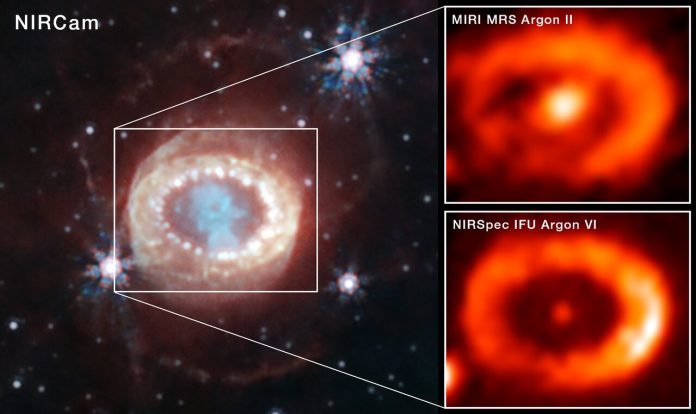In a study reported recently, astronomers observed the SN 1987A remnant using James Webb Space Telescope (JWST). The results showed emission lines of ionized argon and other heavily ionised chemical species from the centre of the nebula around SN 1987A. Observation of such ions means presence of a newly born neutron star as the source of high energy radiation at the centre of the supernova remanent.
Stars are born, age and finally die with an explosion. When the fuel runs out and nuclear fusion in the core of star ceases, the inward gravitational force squeezes the core to contract and collapse. As the collapse begins, in few milliseconds, the core gets so compressed that electrons and protons combine to form neutrons and a neutrino is released for each neutron formed. In the case of supermassive stars,the core collapses in a short span of time with a powerful, luminous explosion called supernova. The burst of neutrinos produced during core-collapse escape into outer space unimpeded due to its non-interactive nature with matter, ahead of photons which are trapped in the field, and acts as a beacon or an early warning of a possible optical observation of supernova explosion soon
SN 1987A was the last supernova event seen in southern sky in February 1987. It was the first such supernova event visible to the naked eye since Kepler’s in 1604. Located 160 000 light-years from Earth in the nearby Large Magellanic Cloud (a satellite galaxy of the Milky Way), it was one of the brightest exploding stars seen in more than 400 years that blazed with the power of 100 million suns for several months and provided unique opportunity to study the phases before, during, and after the death of a star.
The SN 1987A was a core-collapse supernova. The explosion was accompanied by neutrino emission which was detected by two water Cherenkov detectors, Kamiokande-II and the Irvine-MichiganBrookhaven (IMB) experiment about two hours prior to the optical observation. This suggested that a compact object (a neutron star or black hole) should have formed after core collapse, but no neutron star following SN 1987A event or any other such recent supernova explosion was ever directly detected. Though, there is indirect evidence for presence of a neutron star in the remanent.
In a study reported recently, astronomers observed the SN 1987A remnant using James Webb Space Telescope (JWST). The results showed emission lines of ionized argon and other heavily ionised chemical species from the centre of the nebula around SN 1987A. Observation of such ions means presence of a newly born neutron star as the source of high energy radiation at the centre of the supernova remanent.
This is the first time that the effects of high energy emission from the young neutron star have been detected.
***
Sources:
- Fransson C., et al 2024. Emission lines due to ionizing radiation from a compact object in the remnant of Supernova 1987A. SCIENCE. 22 February 2024. Vol 383, Issue 6685 pp. 898-903. DOI: https://doi.org/10.1126/science.adj5796
- Stockholm University. News -James Webb telescope detects traces of neutron star in iconic supernova. 22 February 2024. Available at https://www.su.se/english/news/james-webb-telescope-detects-traces-of-neutron-star-in-iconic-supernova-1.716820
- ESA. News-Webb finds evidence for a neutron star at heart of young supernova remnant. Available at https://esawebb.org/news/weic2404/?lang
***




































